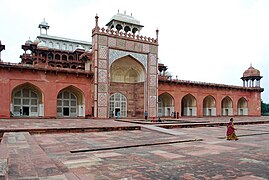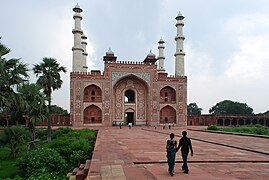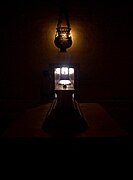阿克巴大帝陵

阿克巴陵(旁遮普语:اکبر دا مقبرہ),又作锡坎德拉(印地语:सिकंदरा),是莫卧儿皇帝阿克巴的陵墓,也是一座莫卧儿风格的建筑钜作,位于印度北方邦阿格拉,建于1604年至1613年间,占地119英亩。
历史

阿克巴大帝陵在其子贾汉吉尔在位期间完工。阿克巴在生前已计划兴建陵墓,并已为此选取了一个合适的位置。在阿克巴驾崩后,其子贾汉吉尔在1605年至1613年间完成了建造工程。奥朗则布在位时,贾特人在拉贾·拉姆(राजाराम)的领导下发动了叛乱,并成功打败莫卧儿军队,占领阿格拉。贾特人把错综复杂的阿克巴大帝陵洗劫一空,盗走了陵墓内的金银珠宝和地毯,并破坏了陵墓内的其他东西,令莫卧儿帝国声威严重受挫。拉贾·拉姆为了报复其父戈库拉之死,更掘开阿克巴的墓穴,打开阿克巴的棺材,把他的骸骨拾走。奥朗则布大怒,并在俘虏拉贾·拉姆后将其无情地处死。[1][2][3][4][5]
第一代凯德尔斯顿的寇松侯爵乔治·寇松在担任印度总督时主导了阿克巴大帝陵的大规模修葺工程;该工程在1905年完成。在1904年古代纪念建筑保护法案通过后,寇松提议修葺阿克巴大帝陵与其他位于阿格拉的历史建筑,并把该工程形容为“对过去的崇敬与送给未来的一份美丽的回忆”。另一方面,该工程有机会是令朝圣者与附近居民不愿到阿克巴大帝陵进行崇拜的一个因素。[6]
位置
阿克巴大帝陵位于阿格拉西北市郊马图拉路(国道2号的一部分)附近,距离市中心约八公里。阿克巴大帝陵约一公里外是玛丽亚姆·萨曼尼皇后陵(阿克巴的皇后、贾汉吉尔之母玛丽亚姆·萨曼尼的陵墓)。[7]
建筑
阿克巴大帝陵的南入口是进入陵墓的正常入口,也是陵墓的主入口,设有四座大理石叫拜楼,叫拜楼设有与泰姬陵的设计相近的穹顶。陵墓本身被四边围墙包围于一个105平方米大的正方形内。陵墓建筑是一四角锥体,其中假墓穴位于建筑顶部的一个大理石亭,真正的墓穴则在建筑的地库内,北部原有一座清真寺,已倒塌。[8]。陵墓建筑主要使用深红色砂岩建造,并使用白色大理石点缀。陵墓及其门楼以砂岩和大理石造嵌板与黑色板岩装饰。嵌板有着几何、花型和书法风的设计,并预示了国柱陵更复杂和隐约的设计[9][10]。
图册
参考文献
- ^ Vīrasiṃha. The Jats: Their Role & Contribution to the Socio-economic Life and Polity of North & North-west India 2. University of Michigan. 2006: 100–102.
- ^ Rap, Edward James; Haig, Wolseley; Haig, Richard. The Cambridge History of India 4. Cambridge University Press. 1937: 305 [2019-04-13]. (原始内容存档于2018-06-29).
- ^ Hansen, Waldemar. The Peacock Throne: The Drama of Mogul India. 1986: 454.
- ^ Reddy. General Studies History for UPSC. Tata McGraw-Hill. 2005: B-46.
- ^ Asher, Catherine Blanshard; Asher, Catherine Ella Blanshard. Architecture of Mughal India - Part 1 4. Cambridge University Press. 1992: 108.
- ^ Rajagopalan, Mrinalini. From loot to trophy: the vexed history of architectural heritage in imperial India (PDF). International Institute for Asian Studies. 2011 [2019-01-03]. (原始内容存档 (PDF)于2019-01-04).
- ^ Smith, R.V. Remembering the Great Emperor. The Hindu. 2003-10-27 [2019-04-14]. (原始内容存档于2019-07-13).
- ^ Fascinating monuments, timeless tales. The Hindu (Chennai, India). 2003-09-22 [2019-04-13]. (原始内容存档于2013-10-19).
- ^ Akbar's Tomb. Archnet.org. (原始内容存档于2010-06-19).
- ^ Asher, Catherine Ella Blanshard. Architecture of Mughal India, Part 1 4. Cambridge University Press. 1992: 107 [2019-04-13]. ISBN 0-521-26728-5. (原始内容存档于2020-01-22).
延伸阅读
- Keene, Henry George. Sikandra. A Handbook for Visitors to Agra and Its Neighbourhood 6. Thacker, Spink & Co. 1899: 43.
- Havell, Ernest Binfield. Sikandra. A Handbook to Agra and the Taj, Sikandra, Fatehpur-Sikri, and the Neighbourhood. Longmans, Green & Co., London. 1904.
外部链接
| ||||||||||||||||||||||||||||||||
Text is available under the CC BY-SA 4.0 license; additional terms may apply.
Images, videos and audio are available under their respective licenses.













